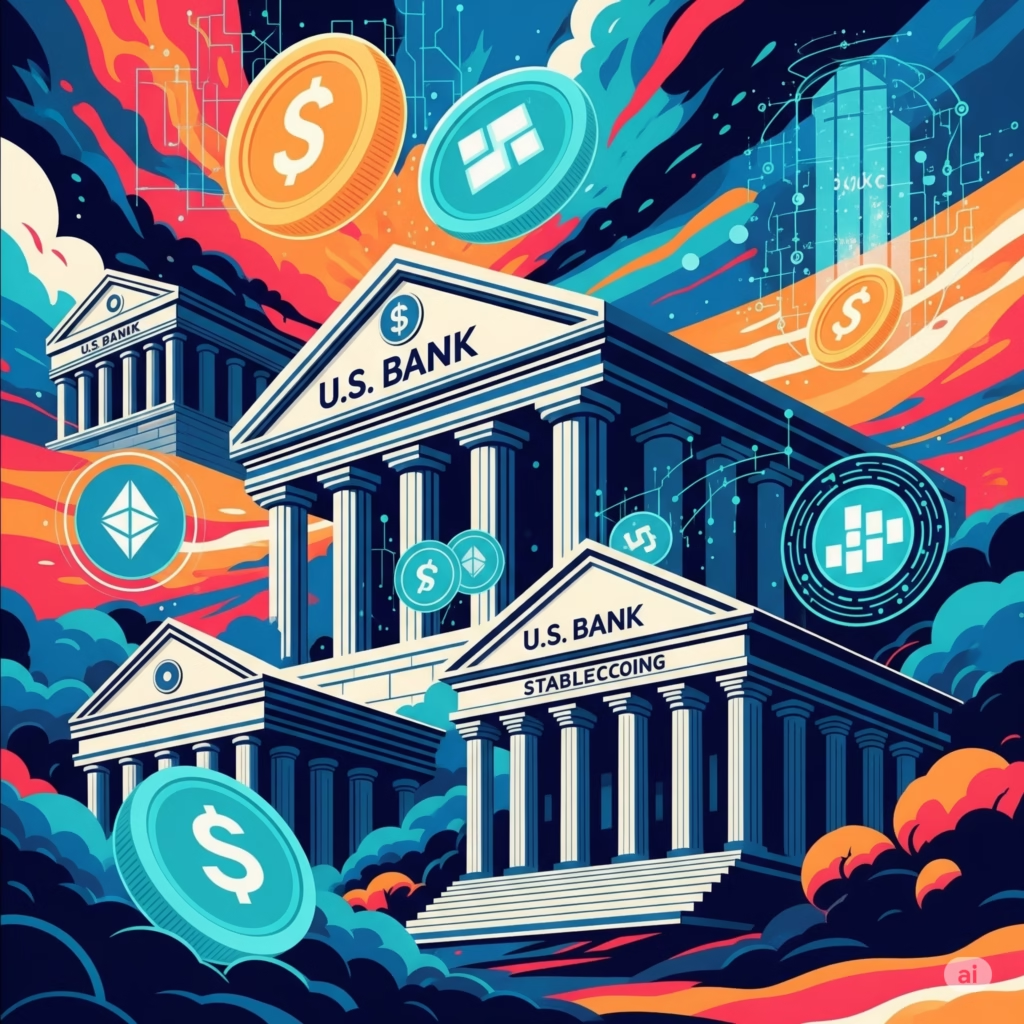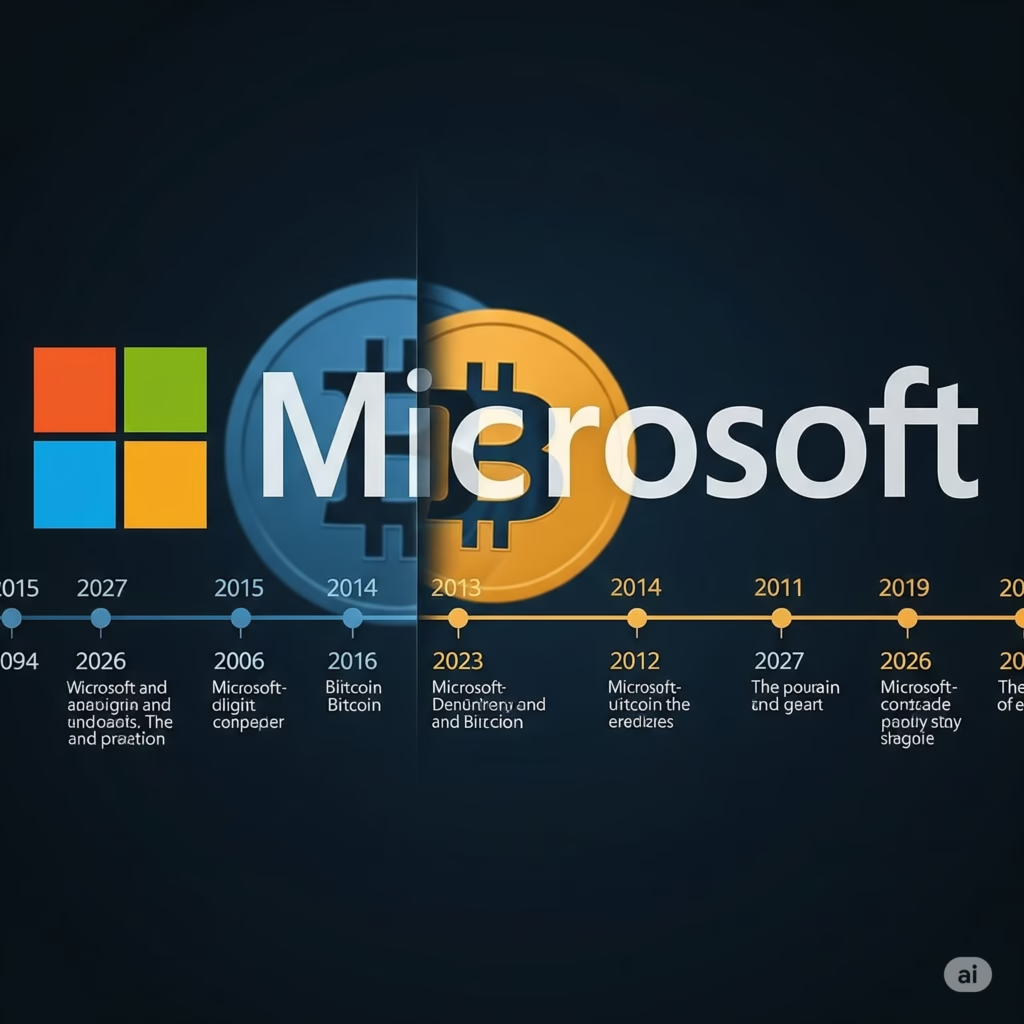In an unprecedented move signaling the financial sector’s deepening trust in blockchain, some of the largest U.S. banks — including JPMorgan Chase, Citigroup, Wells Fargo, and Bank of America — are reportedly collaborating on a joint US Banks stablecoin initiative set to launch in 2025. This effort represents not only a technological shift but a foundational rethinking of how money, regulation, and digital infrastructure intersect.
Stablecoins, digital currencies pegged to real-world assets like the U.S. dollar, have grown explosively in the past five years. While private players like Circle (USDC) and Tether (USDT) dominate the field, banks are finally stepping in to claim their share of the decentralized future. This article explores what this move means for crypto, banking, and the global financial order.
“Banking institutions cannot afford to ignore crypto anymore — the stablecoin proposal is not just defensive, it’s offensive,” said financial analyst Mark Preston, quoted in The Wall Street Journal.

Table of Contents
1.Why Traditional Banks Are Entering Crypto
Institutional FOMO Is Real
Over the last decade, crypto has surged from a fringe experiment to a trillion-dollar asset class. Decentralized Finance (DeFi), which bypasses traditional banks, currently controls more than $95 billion in total value locked (TVL) according to DeFiLlama. This has forced banks to re-evaluate their stance on blockchain technology.
Banks see the writing on the wall: consumers and institutions want faster, cheaper, 24/7 global settlement — something legacy systems can’t offer.
Stablecoin Growth vs Traditional Banking
The combined market cap of USDT and USDC surpasses $135 billion as of Q1 2025, according to CoinGecko. These digital dollars are used widely for trading, remittances, and yield farming. As of now, none of this activity goes through traditional banks — a massive missed opportunity.
The IMF noted in its 2024 Digital Money Report:
“Stablecoins have the potential to replace commercial bank money in both retail and wholesale payments unless banks adapt rapidly.”
Strategic Motivations
Banks aren’t launching a stablecoin just for tech relevance — they’re doing it to:
- Regain control over digital payments
- Preempt regulatory lockdowns
- Counter the rising influence of fintechs like PayPal and crypto firms like Circle
Quote from Bloomberg:
“What we’re seeing is not just banks catching up, but banking trying to reassert itself in a world that’s already moved on,” said Emily Grainger, senior fintech editor at Bloomberg.
2. The Joint US Banks Stablecoin Initiative
The Genesis of the Project
Insiders familiar with the matter told Forbes in late 2024 that discussions between the big four U.S. banks began informally during regulatory roundtables concerning the GENIUS Act — a bipartisan bill promoting innovation in U.S. financial infrastructure while maintaining regulatory oversight on blockchain usage.
The result: a consortium-backed stablecoin project named “USBankCoin” (working title), expected to launch mid-2025.
How It Works
- Blockchain Network: A permissioned, private version of Ethereum (likely Layer 2 optimized for performance)
- Issuance: Fully backed by bank-held USD reserves, each token equals $1
- Access: Through retail banking apps, B2B APIs, and eventually cross-bank interoperability
- Settlement: Instant cross-border settlement using stablecoin rails
- Audits: Monthly attestation reports, with potential oversight by the Federal Reserve or FDIC
Quote – Financial Times
“The private stablecoin market is fractured. A unified effort by American banks could offer a regulatory-safe alternative, especially amid global CBDC uncertainty.”
— Charles Nguyen, economic policy columnist, Financial Times
Impact on Current Crypto Players
This move could significantly pressure existing stablecoin leaders. Circle’s USDC and Tether’s USDT have already faced concerns over reserve transparency. A bank-issued stablecoin, backed by FDIC-insured funds and subjected to bank-grade audits, would likely be more attractive to institutional capital.
“The moment JPMorgan or Citi issues a dollar-pegged token with regulatory blessing, that’s game over for fly-by-night stablecoin operators.” — Lex Sokolin, former CMO at ConsenSys
Will It Be Open Source?
According to sources from Decrypt, the consortium may release part of the codebase under a financial-grade MIT license, allowing FinTechs and developers to integrate without full decentralization — striking a balance between innovation and compliance.
3. Regulatory Background: The GENIUS Act
What Is the GENIUS Act?
Short for Government-Endorsed Network for Innovation Using Stablecoins, the GENIUS Act is a sweeping bill that sets standards for digital asset issuance by U.S. financial institutions.
Signed into law in early 2025, its key provisions include:
- Only FDIC-insured institutions may issue USD-backed stablecoins for mass-market use
- Monthly reserve audits required
- Full KYC/AML compliance for both users and third-party integrators
- Emergency freeze and clawback mechanisms
Why It Matters
The GENIUS Act legitimizes stablecoins as official digital cash, while still gatekeeping who can issue them — mainly the traditional banks and government partners.
“It’s both a blessing and a firewall,” said Laura Shin, host of the Unchained podcast. “Crypto gets official legitimacy, but decentralization loses ground.”
Global Perspective
While the U.S. is rolling out stablecoin regulation, other countries are still debating. The EU’s MiCA framework won’t take full effect until 2026. China has its Digital Yuan. But the U.S. — with USD still the world’s reserve currency — now sets the tone for regulated stablecoins.

4. Expert Analysis, Market Reactions & Global Implications
Wall Street Reacts
Shortly after news broke about the joint bank stablecoin project, traditional financial markets responded with cautious optimism. JPMorgan’s stock rose 3.2%, and Citigroup gained 2.7% within 48 hours — a clear indicator that investors are betting on the digital future of banking.
“The big banks’ entry into stablecoins isn’t just a headline; it’s a structural shift,” said Kathy Wood, CEO of ARK Invest, during an interview with CNBC.
“This may be the gateway for institutional trillions to enter tokenized finance.”
Crypto Market Reaction
The reaction in the crypto market was mixed:
- USDC gained market cap as investors anticipated regulatory alignment
- USDT saw a 2.3% dip amid concerns about increased competition
- Bitcoin and Ethereum showed minor volatility but largely remained stable
“There’s a real divide here. Some see it as validation. Others worry it’s the beginning of crypto’s assimilation into the legacy banking world.”
— Camila Russo, author of The Infinite Machine
Global Ripple Effects
This bank-backed stablecoin project may trigger similar responses abroad:
- UK’s Bank of England is reportedly in talks with HSBC and Barclays for a digital pound pilot
- EU’s MiCA law could accelerate timelines for Euro-backed stablecoins
- India’s RBI may push forward with CBDC trials for wholesale banking
“The dollar remains king. A regulated digital dollar from private banks could become the de facto global stablecoin — especially in emerging markets,” noted The Economist in its April 2025 issue.
5. Opportunities & Risks
Opportunities
- Financial Inclusion: Faster, cheaper remittances for underserved populations in developing countries
- Institutional Trust: Corporations may prefer bank-backed stablecoins for compliance and security
- Payment Revolution: Visa and Mastercard could integrate stablecoins for global transactions
“We envision a future where a transaction from New York to Nairobi settles in seconds — that’s the promise of tokenized banking,” said Al Kelly, Executive Chairman of Visa, in a Time Magazine roundtable.
Risks
- Privacy Concerns: With full KYC/AML, user anonymity is off the table
- Monopoly Fears: A few banks dominating stablecoin issuance could centralize control
- Exclusion of DeFi: Many DeFi protocols may be unable to integrate due to compliance hurdles
Quote – MIT Technology Review
“If this system becomes too insular, it risks becoming a gated version of crypto — undermining the very ethos that birthed blockchain in the first place.”

6. CBDCs vs. Bank Stablecoins: A Comparative Analysis
Central Bank Digital Currencies (CBDCs): The Government Route
CBDCs, like the Digital Yuan, eNaira, and Sand Dollar, are government-issued, centralized digital currencies. Their key traits:
- Direct control by central banks
- Programmable money (can restrict usage/location)
- Full traceability
- Often offline-compatible
In contrast, bank-issued stablecoins like the upcoming USBankCoin are:
- Privately issued, under government oversight
- Limited programmability
- Used primarily for settlement and payments
- KYC-enforced but not directly tied to a central authority
“CBDCs offer control. Stablecoins offer flexibility. We’re watching a digital arms race between central banks and private finance,” said Michael J. Casey, Chief Content Officer, CoinDesk.
Advantages of Bank-Issued Stablecoins
- Faster rollout (existing infrastructure)
- Higher trust among corporates (audited, insured)
- Potential for multi-currency support
- Less risk of government misuse or surveillance
Drawbacks
- Lacks true decentralization
- May marginalize crypto-native players
- Regulatory patchwork still evolving
“The real winner is the one that becomes the default for international settlement,” wrote Reuters in its 2025 Digital Finance Outlook. “And right now, U.S. banks may have the edge.”
7. Stablecoin Wars: Circle, Tether, and the Banks
Circle (USDC)
Circle CEO Jeremy Allaire has welcomed the bank initiative, suggesting that Circle might partner or integrate with USBankCoin.
“It’s not zero-sum. Our goal is to make digital dollars universal — whether that’s USDC, USBankCoin, or both,” he said during an FT Crypto Summit in April 2025.
USDC is seen as the most transparent and regulatory-compliant among current stablecoins. If Circle can collaborate rather than compete, it may survive the coming shift.
Tether (USDT)
Tether, however, is at risk. Despite commanding over $100 billion in market cap, it faces:
- Reserve transparency concerns
- Ban in some countries (e.g., Canada)
- No U.S. bank or regulatory support
“Tether’s dominance is not guaranteed in a regulated era,” said Yaya Fanusie, ex-CIA analyst and crypto policy expert.
Crypto Community’s Divide
There is a visible philosophical split:
- Crypto purists warn this is “Wall Street’s takeover”
- Realists and enterprises say it’s long overdue
“If we want Bitcoin to coexist with the next-gen financial system, we must welcome bridges — even if they come from banks,” tweeted Balaji Srinivasan, tech futurist and ex-Coinbase CTO.
8. The Road Ahead: Predictions, Adoption Timeline & Final Thoughts
Adoption Timeline (2025–2030)
Here’s a realistic timeline for how bank-backed stablecoins could evolve over the next five years: (2025–2030)
2025: Banks test their stablecoins in small pilot programs.
2026: Used for business payments and remittances.
2027: Public rollout via mobile banking apps.
2028: Cross-border payments between top global banks.
2029: Adoption spreads to emerging markets.
2030: Stablecoins become part of everyday transactions worldwide.
Predictions by Global Institutions
- IMF (April 2025 Report): “Private stablecoins backed by regulated banks could serve as dollar-denominated payment rails in regions where CBDCs are years away.”
- World Bank: “We expect digital bank money to reduce remittance costs by 40% in Sub-Saharan Africa and Southeast Asia by 2028.”
- Bloomberg (Crypto Outlook 2025): “The coming years will see a bifurcation — CBDCs for policy control, bank stablecoins for commerce, and crypto-native tokens for innovation.”
What This Means for Crypto Entrepreneurs
This shift is a double-edged sword for founders and developers:
- Opportunities: Integration with bank APIs, tokenized securities, partnerships with fintechs
- Risks: Increased scrutiny, loss of decentralization ethos, compliance barriers
“There’s no turning back. Builders must choose: be part of the system, or build alternatives to it,” wrote Laura Shin in Decrypt.
What This Means for Everyday Users
- Pros: Safer transactions, lower fees, familiar interface (bank apps), consumer protection
- Cons: KYC/AML compliance, zero anonymity, limited DeFi use
“If crypto is to become mainstream, it must also become boring — bank-backed stablecoins might be that necessary compromise,” said Paul Krugman in The New York Times.
A Historic Turning Point
The launch of bank-issued stablecoins in the U.S. marks a watershed moment — where Wall Street finally embraces blockchain, not as competition but as infrastructure.
Crypto will never be the same again. But that doesn’t mean it’s the end — it might just be the beginning of Crypto 2.0: more stable, more secure, and finally, mainstream.
“We started with Silk Road. Now we’re talking about JPMorgan’s blockchain dollar. This is evolution,” tweeted Vitalik Buterin, Ethereum co-founder.
Key Takeaways
- U.S. banks are preparing to launch a regulated, dollar-backed stablecoin
- Major players include JPMorgan, Citigroup, and Wells Fargo
- This move could rival both USDT/USDC and CBDCs globally
- Crypto markets are split — some cheer the legitimacy, others fear centralization
- Experts predict mass adoption between 2025 and 2030
Top 10 FAQs: U.S. Bank Stablecoins in 2025
1. What is a bank-issued stablecoin?
A bank-issued stablecoin is a digital dollar created and backed by a regulated bank. It’s pegged 1:1 to the U.S. dollar and operates on blockchain for faster, secure transactions.
2. How is it different from USDC or USDT?
Unlike Circle (USDC) or Tether (USDT), bank stablecoins are directly issued by banks and typically regulated by U.S. financial authorities, ensuring stricter compliance and auditing.
3. Are these stablecoins the same as CBDCs?
No. CBDCs are issued by central banks (like the Fed), while these stablecoins are issued by private U.S. banks. CBDCs represent government digital money; bank stablecoins represent regulated private money.
4. Will I be able to use a bank stablecoin like cash?
Yes, eventually. By 2027–2028, you might be able to use them for payments, remittances, or saving — just like today’s digital banking apps.
5. Are these coins safe?
Bank-issued coins are likely to be insured or backed by high-quality reserves, making them safer than many existing stablecoins. However, they’re still subject to regulatory changes.
6. Why are U.S. banks launching stablecoins now?
Because demand for fast, cross-border, digital dollars is exploding — and banks don’t want to lose ground to crypto-native companies or foreign CBDCs like China’s Digital Yuan.
7. Will this affect crypto investors?
Yes. These coins could reduce demand for USDT/USDC and shift liquidity toward more regulated systems. It might also increase crypto market stability — or reduce decentralization.
8. What are the benefits for users?
- Faster transactions
- Lower international fees
- Greater transparency
- Government-backed safety (in many cases)
9. Are there privacy concerns?
Yes. Like with most banking systems, full KYC/AML is required, meaning no anonymity. Transactions will likely be monitored by regulators.
10. Could this replace traditional cash or digital wallets?
It could, over time. Bank stablecoins may become a primary method of payment, especially online and across borders — potentially competing with PayPal, Venmo, and crypto wallets.
- RLUSD: The Future of Stablecoins in the Crypto Market
- USDT Regulation Update: The Impact of MiCA on USDT



